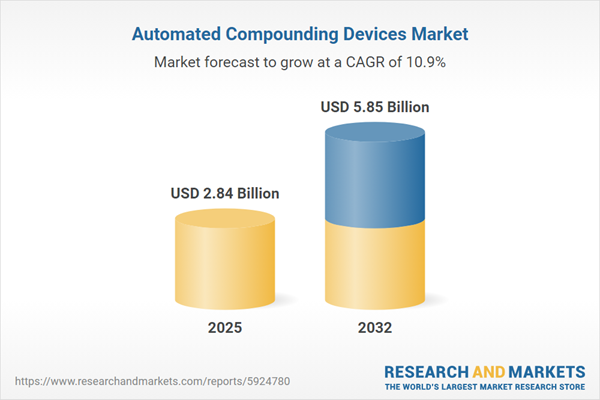Speak directly to the analyst to clarify any post sales queries you may have.
Automated compounding devices are rapidly shifting pharmacy workflows, equipping healthcare leaders to improve compliance, medication safety, and operational performance. Senior decision-makers are turning to automation technologies to address evolving clinical requirements and drive measurable gains in efficiency across their organizations.
Market Snapshot: Automated Compounding Devices Market Growth and Trends
The global automated compounding devices market is experiencing strong growth due to increasing automation adoption and stringent regulatory standards. Market value is expected to grow from USD 2.56 billion in 2024 to USD 2.84 billion in 2025 and reach USD 5.85 billion by 2032, supported by a CAGR of 10.86%.
Healthcare providers are investing in digital solutions to establish transparency and streamline device management, creating new benchmarks for operational oversight. Real-time system integration supports swift adaptation to regulatory changes and enables organizations to remain agile in uncertain industry environments. As a result, the automated compounding devices market is characterized by innovation in transparency, connectivity, and adaptive workflow management.Scope & Segmentation: Strategic Automated Compounding Devices Market Analysis
This executive market research report provides detailed segmentation to inform procurement decisions, optimize supply chain resilience, and support long-term technology planning. Key coverage areas include:
- Device Types: Evaluates peristaltic, piston-driven, and volumetric systems, highlighting their value in achieving precision medication delivery and supporting various compounding complexities.
- Clinical Applications: Analyzes the adoption of automation in specialized care such as analgesia, oncology and chemotherapy, and parenteral nutrition, underscoring expanding pharmacy roles in care coordination.
- End Users: Explores trends across hospital pharmacies, compounding centers, home health providers, and retail pharmacies as each segment adapts to more decentralized care models and shifting patient needs.
- Distribution Channels: Reviews direct and distributor procurement as well as digital platform strategies, demonstrating approaches to building supply chain flexibility in pharmaceutical distribution.
- Software Types: Assesses the impact of workflow management and modular integration solutions on data sharing, reporting, and overall system interoperability, enabling greater insight into pharmacy performance.
- Workflow Types: Covers both batch and continuous compounding models to align technology investments with productivity, resource efficiency, and cost-effectiveness targets.
- Regional Coverage: Provides market and regulatory insights for the Americas, Europe, Middle East & Africa, and Asia-Pacific, each with unique modernization drivers and healthcare priorities.
- Companies Profiled: Delivers competitive analysis for Baxter International Inc., Fresenius Kabi AG, B. Braun Melsungen AG, ICU Medical, Omnicell, Ivenix, Qcore Medical, Telstar S.A., Swisslog AG, and Capsa Healthcare Inc.; coverage includes innovation pipelines and market positioning considerations.
This nuanced segmentation equips organizations to modernize digital workflows, identify optimal market entry strategies, and build resilient, scalable pharmacy automation tailored to their operational needs.
Key Takeaways for Senior Decision-Makers
- Automated compounding enhances medication traceability and reduces compliance risks when compared with traditional manual methods, supporting greater patient safety.
- Implementation improves medication access and reliability across different care settings, enabling both centralized control and effective decentralized service delivery.
- Integrating automated devices with electronic health records and connected robotics strengthens data exchange, facilitating better team coordination and oversight in clinical practice.
- Investments in targeted technologies let organizations match system configurations to unique workflow requirements, helping ensure scalability and adaptability for future growth.
- Collaboration with technology partners and suppliers supports modular solution development and data-driven decision-making across pharmacy management operations.
- Adapting procurement strategies and investing in workforce training increases flexibility for responding to evolving regulatory and clinical standards.
Tariff Impact on Supply Chain and Procurement
Upcoming U.S. tariff adjustments in 2025 are prompting healthcare organizations to refine automated compounding device sourcing and procurement processes. Strategies include diversifying supplier networks, implementing dual-sourcing, and establishing regional assembly sites. These measures facilitate uninterrupted device availability and cost control, helping organizations manage the impact of global trade dynamics on the pharmaceutical supply chain.
Methodology & Data Sources
This report synthesizes in-depth secondary research, interviews with pharmacy and clinical executives, and a comprehensive regulatory review. Validated by data triangulation, findings deliver robust and strategic support for high-stakes decision-making.
Why This Report Matters
- Empowers healthcare executives to benchmark and monitor automation, procurement, and compliance strategies against organizational priorities.
- Facilitates risk reduction and enhances medication safety by providing actionable segmentation and procurement guidance aligned with regulatory standards.
- Enables supply chain leaders to optimize pharmacy operations, supporting ongoing adaptation to evolving care models and dynamic market conditions.
Conclusion
Automated compounding devices enable healthcare organizations to strengthen pharmacy modernization, maintain regulatory confidence, and increase operational flexibility through strategic technology investment.
Additional Product Information:
- Purchase of this report includes 1 year online access with quarterly updates.
- This report can be updated on request. Please contact our Customer Experience team using the Ask a Question widget on our website.
Table of Contents
3. Executive Summary
4. Market Overview
7. Cumulative Impact of Artificial Intelligence 2025
Companies Mentioned
The companies profiled in this Automated Compounding Devices market report include:- Baxter International Inc.
- Fresenius Kabi AG
- B. Braun Melsungen AG
- ICU Medical, Inc.
- Omnicell, Inc.
- Ivenix, Inc.
- Qcore Medical, Inc.
- Telstar S.A.
- Swisslog AG
- Capsa Healthcare, Inc.
Table Information
| Report Attribute | Details |
|---|---|
| No. of Pages | 185 |
| Published | November 2025 |
| Forecast Period | 2025 - 2032 |
| Estimated Market Value ( USD | $ 2.84 Billion |
| Forecasted Market Value ( USD | $ 5.85 Billion |
| Compound Annual Growth Rate | 10.8% |
| Regions Covered | Global |
| No. of Companies Mentioned | 11 |









